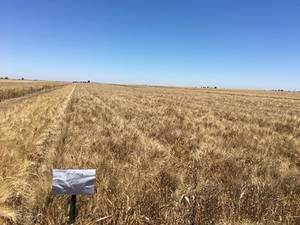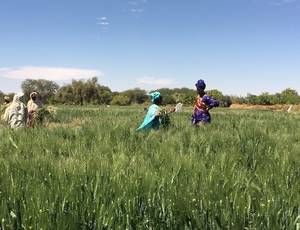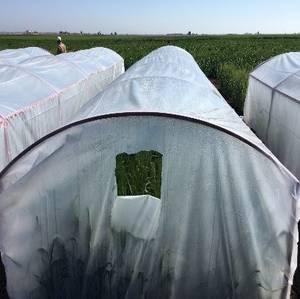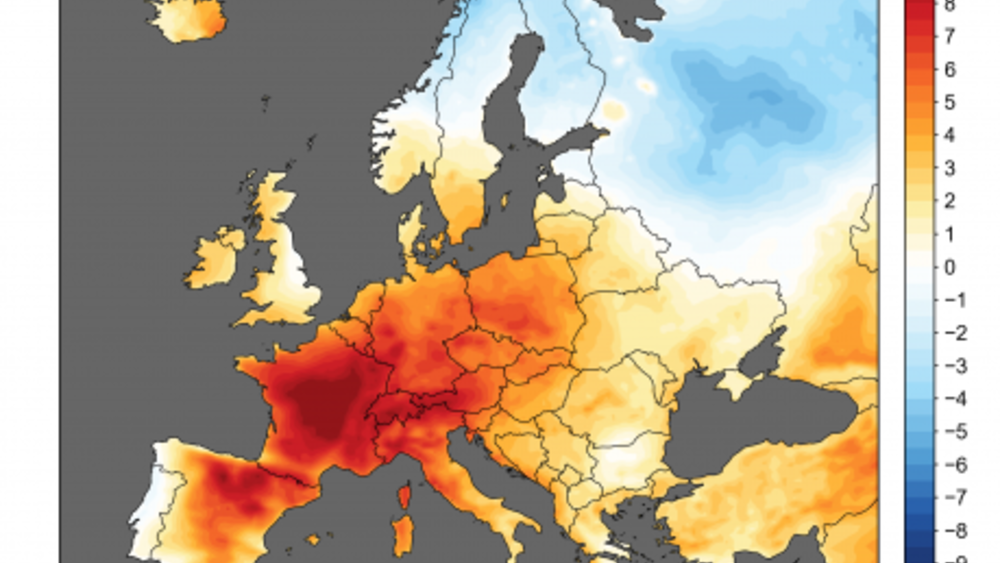3 July 2019. News release from ICARDA. The heat-wave in Europe poses a significant threat to wheat production across the continent. The breeding of heat-tolerant wheat varieties remains one of the most strategic approaches to cope with extremely high temperatures - but Europe is failing to take advantage of the resilient varieties developed and disseminated by the CGIAR and its partners, which offer a robust defense against the warming effects of global climate change.
If a heat-wave like the one recorded these days was to occur 1 month earlier, at the end of May, when the Northern European wheats are in full bloom, it could cause up to 50 percent yield loses, a devastating blow to the European agriculture and food sectors that could cost billions of Euros.
The response of scientists
 Breeding of heat-tolerant wheat varieties remains one of the most strategic approach to cope with the risk of unseasonal heat-waves. The International Center for Agricultural research in Dry Areas (ICARDA) has started in 2012 to utilize field stations that experience continuous heat-stress to select new wheat cultivars better primed to tolerate this stress.
Breeding of heat-tolerant wheat varieties remains one of the most strategic approach to cope with the risk of unseasonal heat-waves. The International Center for Agricultural research in Dry Areas (ICARDA) has started in 2012 to utilize field stations that experience continuous heat-stress to select new wheat cultivars better primed to tolerate this stress.
In Sudan, the experimental farm of Wad Medani was developed together with the Agricultural Research Corporation (ARC) and CIMMYT (International Center for Maize and Wheat Improvement) to test thousands of wheat candidate varieties each year. This station experiences average maximum daily temperatures above 30 °C throughout the growing season, which is less than 100 days long, from planting to harvest. This test was used to identify critical genes controlling heat-tolerant in common wheat, and to release new cultivars of bread wheat and durum wheat (used to make spaghetti) capable of withstanding severe heat.
 Similarly, two heat-stresses experimental farms were developed in West Africa to test durum wheat germplasm. In collaboration with Prof Rodomiro Ortiz of the Swedish University of Agricultural Sciences (SLU) Department of Plant Breeding, the stations of Kaédi in Mauritania and of Fanaye in Senegal were upgraded in partnership with the Centre National de Recherche Agronomique et de Développement Agricole (CNRADA) and the Institut Sénégalais de Recherche Agricole (ISRA).
Similarly, two heat-stresses experimental farms were developed in West Africa to test durum wheat germplasm. In collaboration with Prof Rodomiro Ortiz of the Swedish University of Agricultural Sciences (SLU) Department of Plant Breeding, the stations of Kaédi in Mauritania and of Fanaye in Senegal were upgraded in partnership with the Centre National de Recherche Agronomique et de Développement Agricole (CNRADA) and the Institut Sénégalais de Recherche Agricole (ISRA).
Field testing conducted at these stations - with daily temperatures above 32 °C throughout the cycle
and a season of only 90 days in length - have revealed four new durum wheat cultivars perfectly adapted to tolerate intense heat. The work conducted in West Africa has even resulted in the awarding of the prestigious OLAM Prize for Innovation in Food Security to the team of researchers involved.
Can Europe take advantage of success stories?
In Europe, the situation is more like Australia, and public researchers do not work directly on the commercialization and development of varieties, as this is left as prerogative of the private companies. Instead, public research focus on pre-breeding to develop new breeding techniques and focusing on high-risk, longer-term targets, thereby supporting the private sector and farmers with high-tech innovations.
CGIAR centers like ICARDA and CIMMYT have worked in close collaboration with European Universities and advanced research institutions for a long time to develop and adapt the most novel technologies for pre-breeding. It might also be advantageous for European private sector companies to start taking advantage of CGIAR stress-tolerant wheat varieties and develop a system similar to CAIGE used by Australian breeders (CAIGE= CIMMYT-Australia-ICARDA Germplasm Evaluation project). By taking advantage of similar environments in Morocco and Mediterranean environments in Europe, European breeders can select the promising germplasm of tomorrow and provide the continent’s agricultural sector with a practical defense against future heat-waves.
 Breeding of heat-tolerant wheat varieties remains one of the most strategic approach to cope with the risk of unseasonal heat-waves. The International Center for Agricultural research in Dry Areas (ICARDA) has started in 2012 to utilize field stations that experience continuous heat-stress to select new wheat cultivars better primed to tolerate this stress.
Breeding of heat-tolerant wheat varieties remains one of the most strategic approach to cope with the risk of unseasonal heat-waves. The International Center for Agricultural research in Dry Areas (ICARDA) has started in 2012 to utilize field stations that experience continuous heat-stress to select new wheat cultivars better primed to tolerate this stress.In Sudan, the experimental farm of Wad Medani was developed together with the Agricultural Research Corporation (ARC) and CIMMYT (International Center for Maize and Wheat Improvement) to test thousands of wheat candidate varieties each year. This station experiences average maximum daily temperatures above 30 °C throughout the growing season, which is less than 100 days long, from planting to harvest. This test was used to identify critical genes controlling heat-tolerant in common wheat, and to release new cultivars of bread wheat and durum wheat (used to make spaghetti) capable of withstanding severe heat.
 Similarly, two heat-stresses experimental farms were developed in West Africa to test durum wheat germplasm. In collaboration with Prof Rodomiro Ortiz of the Swedish University of Agricultural Sciences (SLU) Department of Plant Breeding, the stations of Kaédi in Mauritania and of Fanaye in Senegal were upgraded in partnership with the Centre National de Recherche Agronomique et de Développement Agricole (CNRADA) and the Institut Sénégalais de Recherche Agricole (ISRA).
Similarly, two heat-stresses experimental farms were developed in West Africa to test durum wheat germplasm. In collaboration with Prof Rodomiro Ortiz of the Swedish University of Agricultural Sciences (SLU) Department of Plant Breeding, the stations of Kaédi in Mauritania and of Fanaye in Senegal were upgraded in partnership with the Centre National de Recherche Agronomique et de Développement Agricole (CNRADA) and the Institut Sénégalais de Recherche Agricole (ISRA).Field testing conducted at these stations - with daily temperatures above 32 °C throughout the cycle
 |
| Plastic tunnels were placed on the wheat plants at the time of flowering at the ICARDA Marchouch station in Morocco |
In Europe, the situation is more like Australia, and public researchers do not work directly on the commercialization and development of varieties, as this is left as prerogative of the private companies. Instead, public research focus on pre-breeding to develop new breeding techniques and focusing on high-risk, longer-term targets, thereby supporting the private sector and farmers with high-tech innovations.
CGIAR centers like ICARDA and CIMMYT have worked in close collaboration with European Universities and advanced research institutions for a long time to develop and adapt the most novel technologies for pre-breeding. It might also be advantageous for European private sector companies to start taking advantage of CGIAR stress-tolerant wheat varieties and develop a system similar to CAIGE used by Australian breeders (CAIGE= CIMMYT-Australia-ICARDA Germplasm Evaluation project). By taking advantage of similar environments in Morocco and Mediterranean environments in Europe, European breeders can select the promising germplasm of tomorrow and provide the continent’s agricultural sector with a practical defense against future heat-waves.


No comments:
Post a Comment